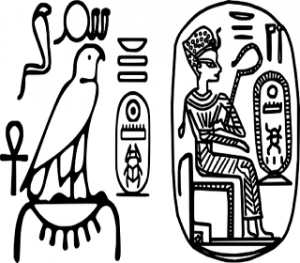



When around 390 AD the Christians destroyed the Serapeum, the last pagan temple survived at that time, for Egypt was the end of hieroglyphic writing, of which the Egyptian priests were always jealous custodians. The Greeks and the Romans admired the Egyptian civilization, but they had never taken care of her writing. They knew only that there were three different kinds of Egyptian writing, namely, hieroglyphics [from the Greek sacred inscriptions], the hieratic writing , considered wrongly as sacred writings, and the demotic, or popular writing , used for the needs of daily life.
The knowledge of the Greeks and the Romans on Egyptian writing ended up there, also because the writing was essentially considered both a trade by them, and unworthy of a free man. The only work devoted to Egyptian writing was that of Horapollo, who lived around the 5th century AD.
“At the beginning of the fifth century Horapollo, a scribe of the Egyptian race, and a native of Phaenebithis, attempted to collect and perpetuate in the volume before us, the then remaining, but fast fading knowledge of the symbols inscribed upon the monuments, which attested the ancient grandeur of his country. This compilation was originally made in the Egyptian language; but a translation of it into Greek by Philip has alone come down to us, and in a condition very far from satisfactory.” (1).
Horapollo was only interested in hieroglyphics that he did not believe a phonetic system of writing, but figurative signs. This mistaken belief remained largely unquestioned until the 19th century. But Horapollo handed down to us his symbolical interpretation of Egyptian hieroglyphics. These are some examples of his studies of this subject:
“To denote Eternity they depict the Sun and Moon because their elements are eternal. But when they would represent Eternity differently, they delineate a Serpent with its tail covered by the rest of its body: the Egyptians call this Ouraius, which in the Greek language signifies Basilisk (‡). And they place golden figures of it round the Gods. The Egyptians say that Eternity is represented by this animal; because of the three existing species of serpents, the others are mortal, but this alone is immortal; and (¶) because it destroys any other animal by merely breathing upon it even without biting. And hence, inasmuch as it thus appears to have power over life and death, they place it upon the head of the Gods.” (2).
“When they would represent the universe, they delineate a serpent be speckled with variegated scales devouring its own tail; by the scales intimating the stars in the universe. The animal is also extremely heavy, as is the earth, and extremely slippery, like the water: moreover, it every year puts off its old age with its skin, as in the universe the annual period effects a corresponding change and renovated. And the making use of its own body for implies, that all things whatsoever that are generated by divine providence in the world undergo a corruption into it again.” (3).
“When they would denote intrepidity, they depict a lion, for he has a great head fiery eyeballs, and a round face, and about it hairs in resemblance of the Sun; and hence it is, that they place lions under the throne of Horus, intimating the connection of the animal with the god. And the Sun is called Horus from presiding over the Hours.” (4).
It is true, as some scholars were saying, that Horapollo noticed “only a few of the symbolical hieroglyphics, and these not always correct,” (5) but we should consider that Horapollo’s symbolical interpretation of Egyptian Hieroglyphics had been the only one in our possession before the discovery of the Rosetta Stone by Champollion, when the symbolical interpretations (typical of the Greeks and the Christians) were abandoned and the real meaning of the Egyptian hieroglyphics was discovered.
Notes
1) The Hieroglyphics of Herapollo Nilous, by Alexander Turner Cory, London, William Pickering, MDCCCXL (1840), pp. VIII-IX.
2) Ivi, pp. 5-6.
3) Ivi, pp. 7-8.
4) Ivi, pp. 38-39.
5) The Elements of Hieroglyphics and Egyptian Antiquities, by Marquis Spineto, London, Rivington, 1845, p. 54.
Nggak Nyangka! Hidup Gue Berubah Total! Gue bukan siapa-siapa. Cuma anak kos biasa yang kerja serabutan buat nutup biaya hidup… Read More
What is the Main Cause of a Heart Attack? What is its Solution? A heart attack is the blockage of… Read More
In the vast economic arena, one term that often takes center stage, inciting extensive debates and discussions, is the "debt… Read More
De-Dollarization: The Changing Face of Global Finance The financial landscape is in a state of flux, with an intriguing economic… Read More
The curtains closed on a dramatic Bundesliga season with Bayern Munich standing tall once again, clinching their 11th straight title.… Read More
The Unfolding Story of Celine Dion's Health In recent news that has left fans across the globe stunned, iconic singer… Read More